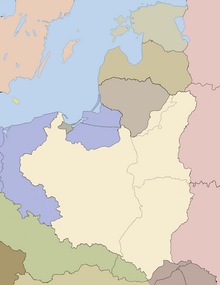
Operation Tannenberg was a codename for one of the anti-Polish extermination actions by Nazi Germany. The shootings were conducted with the use of a proscription list targeting Poland’s elite, compiled by the Gestapo in the two years before the invasion of Poland.

Środa Wielkopolska is a town in western-central Poland, situated in the Greater Poland Voivodeship, about 30 kilometres (19 mi) southeast of Poznań, with 22,001 inhabitants (2009). It is the seat of Środa Wielkopolska County, and of Gmina Środa Wielkopolska.

Jarocin is a town in west-central Poland with 25,700 inhabitants (1995), the administrative capital of Jarocin County in Greater Poland Voivodeship.
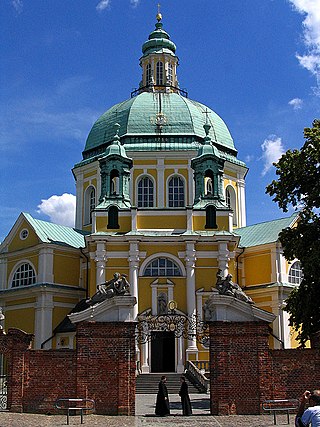
Gostyń is a town in western Poland, seat of the Gostyń County and Gmina Gostyń in the Greater Poland Voivodeship. According to 30 June 2004 data its population was 20,746.

Herbert Lange was a German SS functionary during the Nazi era. He was commandant of Chełmno extermination camp until April 1942, as well as leader of the SS Special Detachment Lange conducting the murder of Jews from the Łódź Ghetto. Lange was responsible for numerous crimes against humanity, including the murder of mentally disabled patients in Poland and in Germany during the Aktion T4 "euthanasia" programme, and became one of the key originators of the Holocaust.

Arthur Karl Greiser was a Nazi German politician, SS-Obergruppenführer, Gauleiter and Reichsstatthalter of the German-occupied territory of Wartheland. He was one of the persons primarily responsible for organizing the Holocaust in occupied Poland and numerous other crimes against humanity. He was arrested by the Americans in 1945, and was tried, convicted and executed by hanging in Poland in 1946 for his crimes, most notably genocide.
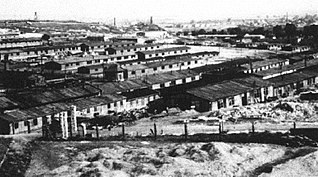
The German camps in occupied Poland during World War II were built by the Nazis between 1939 and 1945 throughout the territory of the Polish Republic, both in the areas annexed in 1939, and in the General Government formed by Nazi Germany in the central part of the country (see map). After the 1941 German attack on the Soviet Union, a much greater system of camps was established, including the world's only industrial extermination camps constructed specifically to carry out the "Final Solution to the Jewish Question".

Gerhard Friedrich Ernst Flesch was a German SS functionary during the Nazi era. After World War II, he was tried, found guilty and executed for his crimes, specifically the torture and murder of members of the Norwegian resistance movement.
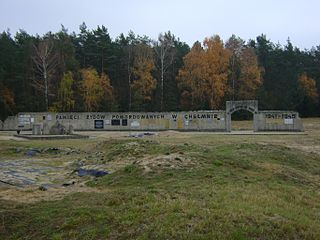
Chełmno or Kulmhof was the first of Nazi Germany's extermination camps and was situated 50 km (31 mi) north of Łódź, near the village of Chełmno nad Nerem. Following the invasion of Poland in 1939, Germany annexed the area into the new territory of Reichsgau Wartheland. The camp, which was specifically intended for no other purpose than mass murder, operated from December 8, 1941, to April 11, 1943, parallel to Operation Reinhard during the deadliest phase of the Holocaust, and again from June 23, 1944, to January 18, 1945, during the Soviet counter-offensive. In 1943, modifications were made to the camp's killing methods as the reception building had already been dismantled.

Buk is a town in Poznań County, in the Greater Poland Voivodeship, in central Poland. As of December 2021, the town has a population of 5,903.

Wolsztyn is a town in western Poland, on the western edge of Greater Poland Voivodeship. It is the seat of Wolsztyn County, and of the smaller administrative district of Gmina Wolsztyn.
Poznań, today Poland's fifth largest city, is also one of the country's oldest cities, and was an important political and religious center in the early Polish state of the 10th century. Poznań Cathedral is the oldest church in the country, containing the tombs of the first Polish rulers, Duke Mieszko I and King Bolesław I Chrobry.
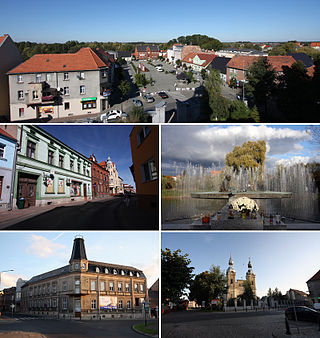
Zbąszyń is a town in western Poland, in Greater Poland Voivodeship, in Nowy Tomyśl County. It is the administrative seat of Gmina Zbąszyń.

Karl Heinrich Wilhelm Koppe was a German Nazi commander. He was responsible for numerous atrocities against Poles and Jews in Reichsgau Wartheland and the General Government during the German occupation of Poland in World War II.
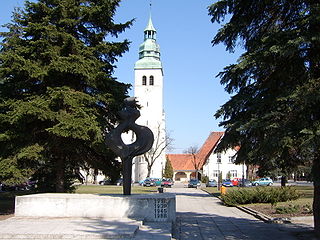
Żabikowo is a district of Luboń, Poland, located in the western part of the town, however without an administrative function.
Helmut Hermann Wilhelm Bischoff was a German SS-Obersturmbannführer, Gestapo officer and Nazi official. During World War II he was the leader of Einsatzkommando 1/IV in Poland and later headed the Gestapo offices in Poznań (Posen) and Magdeburg.
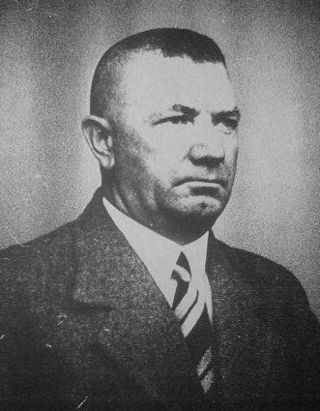
Ernst Damzog was a German policeman, who was a member of the SS of Nazi Germany and served in the Gestapo. He was responsible for the mass murder of Poles and Jews committed in the territory of occupied Poland during World War II.
The following is a timeline of the history of the city of Poznań, Poland.

Greater Poland, often known by its Polish name Wielkopolska, is a Polish historical region of west-central Poland. Its chief and largest city is Poznań followed by Kalisz, the oldest city in Poland.

Marcin Rożek was a Polish sculptor and painter and co-founder and professor at the School of Decorative Arts in Poznań. Rożek is most closely associated with the region of Greater Poland and the city of Poznań, in particular, although he was a well-established and highly regarded artist throughout Poland during the 1920s and 1930s.

